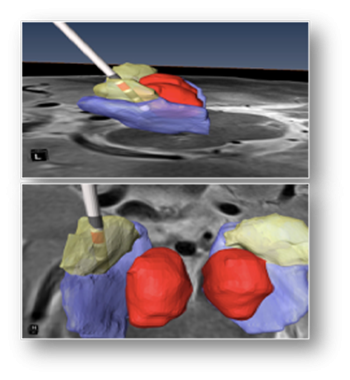
At Duke, researchers are using artificial intelligence to building an antomical brain map for each individual patient, which will allow more neurosurgeons to be able to offer deep brain stimulation treatments to people with Parkinson's disease.
Parkinson’s disease, which afflicts one million Americans, causes both unwanted movements, such as hand tremors, as well as difficulty in initiating movements, such as taking a step. These symptoms interfere with the ability to do many everyday activities most people take for granted.
Medicines help, but lose their power as the disease progresses.
Another, newer option is deep brain stimulation, in which small pulses of electricity are delivered to the brain using an implanted electrode. If the implantation is successful, a patient’s motor symptoms can be reduced significantly.
This technology is made possible by an ever-growing understanding of brain anatomy and the roles played by its various parts. The subthalmic nucleus (STN), for example, is part of the basic movement circuitry in the brain. In Parkinson’s patients, the STN fires in synchrony with other areas of the brain when it shouldn’t, causing problems with movement.
Pulses of electricity can disrupt this faulty firing. Cameron McIntyre, Ph.D., an expert in deep brain stimulation, says, “You’re not necessarily restoring the brain back to normal. You’re overriding pathological activity and replacing it with white noise.” McIntyre will be joining the Duke faculty in July 2021 with appointments in biomedical engineering and neurosurgery.
The problem? The STN is tiny, just larger than a grain of rice. “First you need to figure out where the STN is,” McIntyre says. “Each person’s brain is different — your brain and my brain and your neighbor’s brain are so different in size and shape it’s crazy. Once you find it, there are parts within that little area you want to stimulate and parts you don’t.”
Even for brain surgeons, navigating this maze is not a trivial task.
That’s where Guillermo Sapiro, Ph.D., comes in. Sapiro is the James B. Duke Distinguished Professor of Electrical and Computer Engineering, with appointments in computer science and mathematics. He is also a pioneering figure in artificial intelligence (AI) research. Sapiro wields his expertise in AI to solve societal problems, particularly those related to health and health care.
In the Parkinson’s project, Sapiro uses a technique called machine learning to help neurosurgeons home in on the precise area where the electrode should go. By “learning” on existing MRI images where experts identified the target location, a computer program he created can now predict the precise spot for electrode placement on any new MRI image.
The tool, which essentially builds an anatomical brain map for each individual patient, will allow more brain surgeons to be able to offer the surgery to Parkinson’s patients.
Sapiro collaborates closely on the project with a team of surgeons and scientists that includes not only McIntyre, but also Warren Grill, Ph.D., professor of biomedical engineering, and Dennis Turner, M.D., a neurosurgeon and professor in the departments of neurosurgery, biomedical engineering, neurobiology and orthopaedic surgery.
“We have a comprehensive system where we can go from design to surgery,” Sapiro says. “If we didn’t have such expertise in neurosurgery, we would be stuck with our idea but it would be hard to put into practice.”